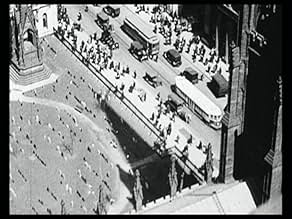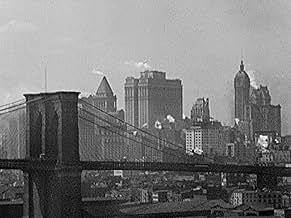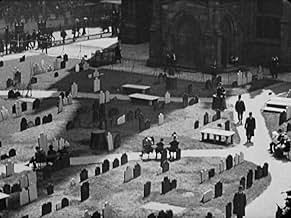IMDb रेटिंग
6.6/10
1.7 हज़ार
आपकी रेटिंग
अपनी भाषा में प्लॉट जोड़ेंThis groundbreaking silent documentary captures the beauty and majesty of the New York City in its streets, skyscrapers, bridges, rail yards and harbors.This groundbreaking silent documentary captures the beauty and majesty of the New York City in its streets, skyscrapers, bridges, rail yards and harbors.This groundbreaking silent documentary captures the beauty and majesty of the New York City in its streets, skyscrapers, bridges, rail yards and harbors.
- निर्देशक
- लेखक
- पुरस्कार
- कुल 1 जीत
फ़ीचर्ड समीक्षाएं
One of the earliest "city symphonies", and arguably one of the most groundbreaking avant garde films of the 1920's, 'Manhatta' is a lyrical, slow, and moving tribute to a great American city based loosely off of a Walt Whitman poem. The imagery isn't as intense and vibrant as that in many other films of a similar nature, whether they be other city symphonies or just other avant garde/experimental films in general, but there are several shots in here that definitely widened my eyes. The very specific positioning of the camera for certain angles helped give much of the short film a very epic feel. At some points, it even felt extremely futuristic and, to me, evoked some shots from Fritz Lang's legendary classic 'Metropolis'. It's only about twelve minutes, so any fan of experimental film might as well check it out as it is highly revolutionary and visually pleasing.
This groundbreaking silent documentary captures the beauty and majesty of the New York City in its streets, skyscrapers, bridges, rail yards and harbors.
Is this film groundbreaking? I would have to agree with that. But unfortunately, it doesn't break nearly as much ground as it could. The film reminds me of "Berlin", the documentary made by Karl Freund and Carl Mayer, among others. The big difference being that "Manhatta" is not particularly long.
And that is why I can only give it so much love, because I wish more of 1920s New York was captured on film, an era that is still remembered fondly today (2017). Any document would be somewhat priceless to the right people.
Is this film groundbreaking? I would have to agree with that. But unfortunately, it doesn't break nearly as much ground as it could. The film reminds me of "Berlin", the documentary made by Karl Freund and Carl Mayer, among others. The big difference being that "Manhatta" is not particularly long.
And that is why I can only give it so much love, because I wish more of 1920s New York was captured on film, an era that is still remembered fondly today (2017). Any document would be somewhat priceless to the right people.
Manhatta (1921)
**** (out of 4)
Cinematographer Paul Strand and painter Charles Sheeler teamed up to make this movie, which was their attempt to show their love for the city of Manhattan. The say they achieved in showing that love would be an understatement because this 11-minute movie is extremely well-made and contains some downright break taking visuals. The semi-documentary film has various images of the city put together in no real order nor do they try to tell a story out of the images. Instead we just see various items from the city, ranging from haze rising over buildings to various ships on the water. All of these images make for an incredible film because it really seems like you're watching a science-fiction film with a bunch of fake images. It's rather amazing at how well the cinematography is here because unlike many, or perhaps any film, this one here puts you so close to what you're looking at that it's nearly impossible to remember you're watching a movie. This is certainly one of the most beautiful looking films I've seen and perhaps the start of what would become avant-garde film and one has to wonder if Stanley Kubrick saw this and learned from it.
**** (out of 4)
Cinematographer Paul Strand and painter Charles Sheeler teamed up to make this movie, which was their attempt to show their love for the city of Manhattan. The say they achieved in showing that love would be an understatement because this 11-minute movie is extremely well-made and contains some downright break taking visuals. The semi-documentary film has various images of the city put together in no real order nor do they try to tell a story out of the images. Instead we just see various items from the city, ranging from haze rising over buildings to various ships on the water. All of these images make for an incredible film because it really seems like you're watching a science-fiction film with a bunch of fake images. It's rather amazing at how well the cinematography is here because unlike many, or perhaps any film, this one here puts you so close to what you're looking at that it's nearly impossible to remember you're watching a movie. This is certainly one of the most beautiful looking films I've seen and perhaps the start of what would become avant-garde film and one has to wonder if Stanley Kubrick saw this and learned from it.
10DaveLB-3
Instead of having a filmmaker attempting to be painterly, this poetic gem boasts both a major painter (Sheeler) and a major photographer (Strand) collaborating.
This is the earliest view of Manhattan we have that is neither simple-minded documentation nor backdrop to melodrama. The visuals are striking, and stand up well to later, more gimmicky, film realizations of what makes Skyscraper National Park so special.
The Walt Whitman title cards would probably have worked better as voiceover narration in the sound era, but offer a strong romantic framework for the powerful imagery. A classic, not to be missed.
This is the earliest view of Manhattan we have that is neither simple-minded documentation nor backdrop to melodrama. The visuals are striking, and stand up well to later, more gimmicky, film realizations of what makes Skyscraper National Park so special.
The Walt Whitman title cards would probably have worked better as voiceover narration in the sound era, but offer a strong romantic framework for the powerful imagery. A classic, not to be missed.
This short film by Sheeler and Strand is the father of American avant-garde cinema.
It contains beautiful shots of Manhattan shown intertwined with excerpts of a Walt Whitman poem. All of the shots are thought out, and very photographic in nature. But that is expected with Paul Strand behind the camera.
This film is probably the first American avant-garde film, and if it isn't, it is definitely the first influential avant-garde film. A guideline for future American avant-garde filmmakers to follow.
A true visual treat, even for today's standard.
It contains beautiful shots of Manhattan shown intertwined with excerpts of a Walt Whitman poem. All of the shots are thought out, and very photographic in nature. But that is expected with Paul Strand behind the camera.
This film is probably the first American avant-garde film, and if it isn't, it is definitely the first influential avant-garde film. A guideline for future American avant-garde filmmakers to follow.
A true visual treat, even for today's standard.
क्या आपको पता है
- ट्रिवियाThe poet whose works are quoted during the film is Walt Whitman.
- भाव
Title Card - Walt Whitman: "City of the world - for all races are here, City of tall facades of marble and iron, Proud and passionate city."
- इसके अलावा अन्य वर्जनThis film was published in Italy on an DVD anthology entitled "Avanguardia: Cinema sperimentale degli anni '20 e '30", distributed by DNA Srl. The film has been re-edited with the contribution of the film history scholar Riccardo Cusin . This version is also available in streaming on some platforms.
- कनेक्शनFeatured in The Secret Life of Sergei Eisenstein (1987)
टॉप पसंद
रेटिंग देने के लिए साइन-इन करें और वैयक्तिकृत सुझावों के लिए वॉचलिस्ट करें
विवरण
- चलने की अवधि11 मिनट
- रंग
- ध्वनि मिश्रण
- पक्ष अनुपात
- 1.33 : 1
इस पेज में योगदान दें
किसी बदलाव का सुझाव दें या अनुपलब्ध कॉन्टेंट जोड़ें




















